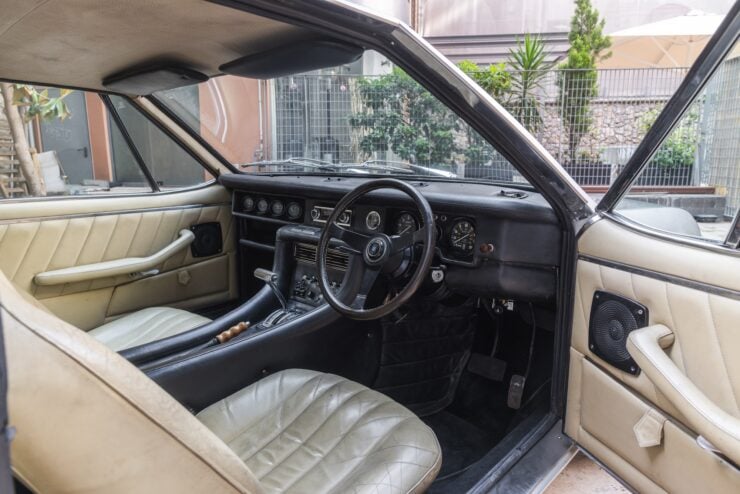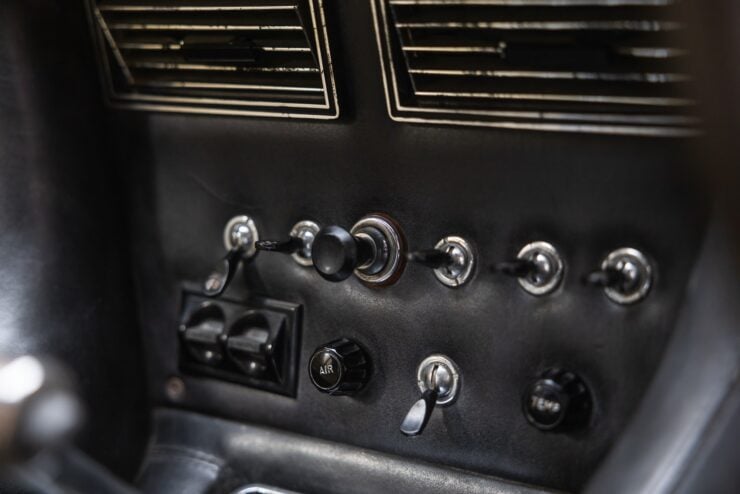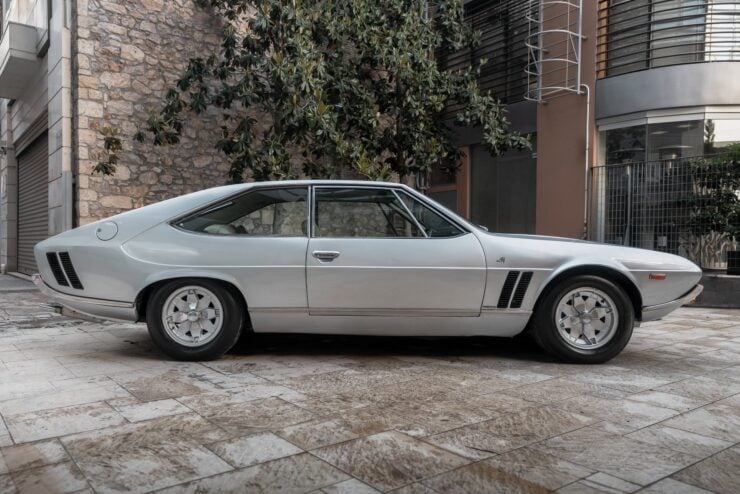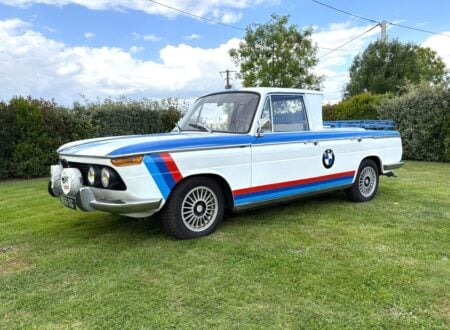The Iso Rivolta Lele, also known as the Iso Lele, was unveiled at the 1969 New York International Auto Show as a shot across the bow of Lamborghini, specifically the Lamborghini Espada which had been released just one year previously.
The team at Iso had even hired the same designer from the Espada project, Marcello Gandini of Bertone. Gandini set to work, and styled an attractive new coupe with 2+2 seating, a modest trunk, a front-mounted V8, and rear wheel drive.
Fast Facts – The Iso Rivolta Lele
- The Iso Rivolta Lele, named after Piere Rivolta’s wife Rachelle “Lele” Rivolta, debuted at the 1969 New York International Auto Show. It was designed by Marcello Gandini, the same designer behind the Lamborghini Espada and many other icons, and featured a 2+2 seating arrangement, modest trunk space, a front-mounted V8, and rear-wheel drive.
- Iso Automoveicoli used American V8 engines, initially from Chevrolet and later from Ford due to a dispute. These engines were simpler, more reliable, and easier to maintain than the complex V12s used by Ferrari and Lamborghini. The Lele’s V8 engines provided power outputs from 300 bhp to 360+ bhp, enabling top speeds of over 225 km/h (140 mph).
- The Lele was built on the pre-existing Bizzarrini designed Iso IR 300 chassis, featuring a sophisticated suspension system with unequal length double wishbones at the front and a de Dion layout at the rear. It was equipped with disc brakes at all four corners, with inboard discs at the rear to reduce unsprung weight.
- The Lele offered a luxurious interior with leather seats, plush carpeting, wood trim, air conditioning, and electric windows. It provided adequate space for four occupants, though the rear seats were more suitable for children or short trips. Production lasted from 1969 to 1974, with approximately 285 cars built, including around 160 Ford-engined models. The Lele remains a lesser-known but desirable collector’s car, and far more affordable than the Espada.
Iso Automoveicoli
The Iso Lele was famously named after Piere Rivolta’s wife Rachelle Rivolta, whose nickname had been “Lele” since childhood. This new car would be based on the pre-existing Bizzarrini designed Iso IR 300 chassis, with V8 engines sourced from the United States, an opulent interior, and a price designed to undercut its more exotic rivals from Ferrari and Lamborghini.


The complex V12 fitted to the production cars of Ferrari and Lamborghini at this time were both a blessing, and dare I say it, occasionally a curse. They could be temperamental, they required specialist servicing, specially trained mechanics, and repairs could be costly.
Italian automaker Iso Automoveicoli S.p.A., better known simply as Iso (pronounced “ee-so”), got around the expensive V12 dilemma by simply buying and fitting American V8s. These engines were mechanically straightforward, but they offered excellent power output, good reliability, and perhaps most importantly, parts were cheap and any mechanic could work on them due to their simplicity.
This combination of an Italian designed chassis, suspension, and body, combined with an American V8 had worked remarkably well for Iso ever since the introduction of their first luxury GT car, the Iso Rivolta IR 300 of 1962.
Other cars would follow, including the elegant Iso Grifo, the Iso Fidia, the later Iso Grifo 7 Litri, and of course, the Iso Lele produced from 1969 to 1974. Iso would never attain the same status as Ferrari, Lamborghini, or Maserati, but they’re now treasured by collectors the world over, who often mention the significantly reduced maintenance bills.
The Iso Lele
The Iso Lele was developed as a compact 2+2 sporting GT car, offering seating for four, adequate trunk space, and performance that would embarrass all but the most exotic of sports cars. The development of the Lele was considerably accelerated by their decision to base it on the same fundamental chassis as the earlier Iso IR 300, they also opted to use a Chevrolet V8, and an off the shelf transmission.


The body was styled by Marcello Gandini of Bertone, as noted above he was also the designer of the Lamborghini Espada which was released just a year earlier. The Espada, with its hefty front-mounted V12, rear wheel drive, seating for four, and its luxurious interior, had proven to be a success for Lamborghini – and Iso wanted to see if a similar recipe would work for them.
The Iso Rivolta Lele: Specifications
Initially the use of Chevrolet V8s worked well for Iso, they were mated to 4-speed manual transmissions, which would later be succeeded by 5-speed manual units with optional 4-speed automatics available for those who wanted them. Later examples of the Lele would be powered by the Ford Cleveland V8 after a dispute with General Motors, who had wanted to switch to an advance payment program for their engines.
This switch from Chevrolet to Ford V8s took place during 1972 after approximately 125 cars had been built, power increased from 300 bhp to 325 bhp as a result. The rest of the car remained much the same, with unequal length double wishbone suspension up front on coil springs with telescopic shock absorbers. In the rear you’d find a de Dion layout, a Salisbury axle, dual trailing arms, and a Watts linkage with telescopic shock absorbers.
Disc brakes were fitted at all four corners, with inboard discs in the rear to help reduce unsprung weight. With a curb weight of 1,610 kgs (or 3,549 lbs), the Lele wasn’t a lightweight, but the power and torque output from the V8 more than made up for it, resulting in a top speed of 225+ km/h (140+ mph) depending on the specific engine used.
Inside the Lele would would find a well appointed interior with leather seats and doors, plush carpeting, wood trim, a radio, air conditioning, and electric windows. There are two front bucket seats, as you would expect, and the two rear seats aren’t huge but they can comfortably accommodate children, or adults on shorter trips.
By the time production ceased in 1974 just 285 or so cars had been made, with approximately 160 of these being the Ford-engined models. Today they’re one of the lesser-known Gandini-Bertone designs from the era, and as a result it’s still possible to buy one for a sum in the five figure range – the same can not be said of the Espada.


The Iso Lele you see here is a 1974 model fitted with the popular combination of a Ford Cleveland V8 and a 4-speed automatic transmission. It was given a restoration some years ago now, and has most recently been a member of the Hellenic Motor Museum in Athens.
The car is now due to roll across the auction block with RM Sotheby’s in England on the 12 of June. It has a price guide of £30,000 – £40,000, or approximately $38,000 – $50,000 USD, making it 1/3rd to 1/5th the cost of an Espada. You can visit the listing here if you’d like to read more about it or register to bid.
















Images: Triadafyllos Xanthopoulos ©2024 Courtesy of RM Sotheby’s








